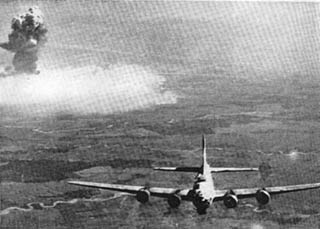DESTROYING HITLER'S OIL Bombers returning from a mission to Ploesti | SIR WINSTON CHURCHILL called Ploesti, Romania, "the taproot of German might", because this is where the Nazi Third Reich obtained much of its oil. Five oil refineries circled the city--Ploesti was "the premier oil target of the continent"--thus one of Europe's most heavily-defended cities. According to World War II historians, Ploesti will always be a symbol of surpassing bravery in air warfare. No less than seven Congressional Medals of Honor were awarded for extraordinary heroism by Army Air Force servicemen over that Romanian city. Lt. Don Wise, as part of the occupation in Germany after the war, was told by former German soldiers that after Ploesti was destroyed, there was virtually no fuel left for Germany's war machine. Soldiers had to push trucks to the top of the hills, then jump on the trucks and ride them downhill. |
DESTROYING THE "TAPROOT OF GERMAN MIGHT" |
The German commander in charge of Ploesti, General Alfred Gerstenberg, had provisioned Ploesti with 2,000 smoke generators, placed in patterns to take advantage of the prevailing winds, to help conceal the refineries. Gerstenberg's anti-aircraft battery concentration became the heaviest in the world.
The first large-scale (five B-24 groups) Army Air Force attack on Ploesti was on Aug. 1, 1943. An estimated 40 percent of refining capacity was put out of service, but at a terrible cost of men and planes. The Army Air Force was not able to follow up decisively because of other commitments, including support of the imminent invasion of Italy. Ploesti was soon back on line. James Dugan and Carroll Stewart, in their landmark book, Ploesti, wrote that after the first attack on Ploesti, General Gerstenberg "obtained more guns, more radar, and thousands of smoke generators to conceal the refineries. He barely held his fighter strength, but his anti-aircraft became the heaviest concentration in the world. The build-up in Romania was matched by the swelling power of the Mediterranean Allied Air Force. The Fifteenth U.S.A.A.F. in Italy was stacking up hundreds of gleaming Liberators and Fortresses with new smartly trained crews." Ploesti, p. 250. In the spring and summer of 1944, the 15th Air Force opened a sustained campaign against oil targets, including Ploesti, Before the refineries around that city were shut down by bombing (and the city captured by the Soviets), nearly 60,000 airmen had flown against those pinpoint targets, dropped some 13,000 tons of bombs, lost 350 heavy bombers, and left more than 3,000 airmen killed or captured. Fifteenth Air Force raids were considerably larger than the first attack of August, 1943. For example, on June 23, 1944, in one of its major strikes, the Fifteenth sent 761 bombers to Romanian oil targets. Don Wise flew a total of six missions to Ploesti, including the dangerous May 18, 1944 mission, which earned the 463rd Bomb Group a Unit Presidential Citation for bravery. The Citation was presented to the Unit on November 7, 1944 in the name of the President of the United States, by order of the Secretary of War and General George C. Marshall, Chief of Staff. The Citation reads in part: The 463d Bombardment Group is cited for outstanding performance of duty in armed conflict with the enemy. Assigned the mission to attack and destroy the Romano Americano Oil Refinery, Ploesti, Rumania, in an effort to reduce the total Axis oil production to a critical point in her military requirements . . . [O]n 18 May 1944, thirty-five B-17 type aircraft, heavily loaded with maximum tonnage, were airborne, and despite adverse weather conditions rallied with the wing formation and set course for their destination. Under continued adverse weather conditions encountered enroute, the visibility became so limited, with dense cloud layers reaching to 30,000 foot elevation, that all other units returned to base. Undaunted by the seemingly overwhelming odds, the 463d Bombardment Group continued on alone through the dense cloud coverage, which rendered compact formation flying extremely hazardous. Despite intense, heavy, and accurate enemy anti-aircraft fire encountered over the target, the gallant crews, displaying outstanding courage, professional skill, and determination, though many of their airplanes were damaged severely, maintained their tight formation and brought their ships through the enemy defenses for a highly successful bomb run, inflicting grave damage to vital enemy installations and supplies. Rallying off the target after the bombing run and while unprotected by friendly fighters, the group was savagely attacked by approximately 100 highly aggressive enemy fighters. In the ensuing fierce engagement, while battling their way through the heavy opposition, the group lost 7 bombers; however, in the gallant defense of the formation, the gunners accounted for 28 enemy aircraft destroyed, 30 probably destroyed, and 2 damaged. . . . [T]he 463d Bombardment Group has upheld the highest traditions of the military service, thereby reflecting great credit on themselves and the armed forces of the United States." BY ORDER OF THE SECRETARY OF WAR. G.C. MARSHALL, Chief of Staff |
C O N T E N T S:
Distinguished Flying Cross |
"Pig Chaser" & Its Crew |
The "Best Seat in the House" |
List of 50 Missions |
The Ploesti Campaign |
Medals and Citations |
From the Newspaper |
About Don Wise |
Links to Other Sites |
Return to Home Page |
This Website Designed, Created and Maintained by John K. Wise, Youngest Son of Donald Wise
This site has been restored by Jimmy in memory of John Keith Wise (guestbook)